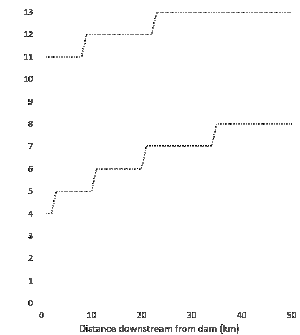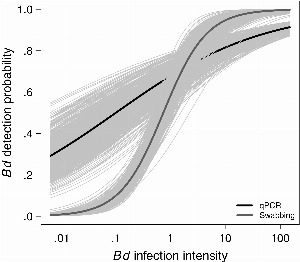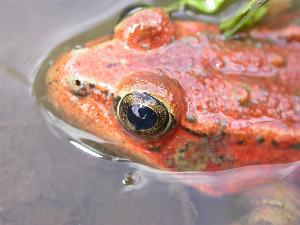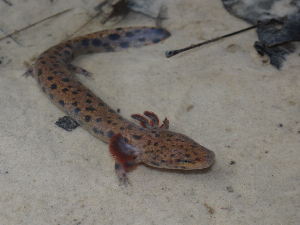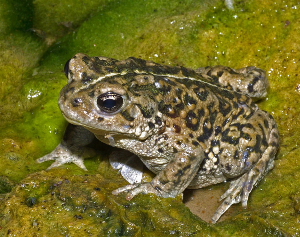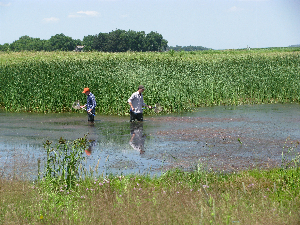Search ARMI Database
Search term(s)
Contribution Number
Search Results
879 record(s) found.
Papers & Reports Occurrence of Batrachochytrium dendrobatidis in anurans of the Mediterranean region of Baja California, México
Authors: A Peralta-Garcia; Andrea J Adams; P Galina-Tessaro; Cheryl J Briggs; J Valdez-Villavicencio; B Hollingsworth; H B Shaffer; Robert N Fisher
Date: 2018-03-08 | Outlet: Diseases of Aquatic Organisms
Chytridiomycosis is caused by the fungal pathogen Batrachochytrium dendrobatidis (Bd) and is regarded as one of the most significant threats to global amphibian populations. In M?xico, Bd was first reported in 2003 and has now been documented in 13 states. We visited 33 localities and swabbed 199 wild-caught anurans from seven species (five native, two exotic) across the Mediterranean region of the state of Baja California. Using quantitative PCR, Bd was detected in 94 individuals (47.2% of samples) at 25 of the 33 survey localities for five native and one exotic frog species. Only the non-native Xenopus laevis tested negative for Bd. We found significant differences between mean Bd loads of different species, and that remoteness and distance to agricultural land were the best positive predictors of Bd prevalence. These are the first Bd-positive results for the state of Baja California and its presence should be regarded as an additional conservation threat to the region?s native frog species.
Papers & Reports Influence of damming on anuran species richness in riparian areas: A test of the serial discontinuity concept
Authors: J C Guzy; E A Eskew; Brian J Halstead; S J Price
Date: 2018-01-26 | Outlet: Ecology and Evolution
Almost all large rivers worldwide are fragmented by dams, and their impacts have been
modeled using the serial discontinuity concept (SDC), a series of predictions regarding
responses of key biotic and abiotic variables. We evaluated the effects of damming on
anuran communities along a 245-km river corridor by conducting repeated, timeconstrained
anuran calling surveys at 42 locations along the Broad and Pacolet Rivers
in South Carolina, USA. Using a hierarchical Bayesian analysis, we test the biodiversity
prediction of the SDC (modified for floodplain rivers) by evaluating anuran occupancy
and species diversity relative to dams and degree of urbanized land use. The mean
response of the anuran community indicated that occupancy and species richness
were maximized when sites were farther downstream from dams. Sites at the farthest
distances downstream of dams (47.5 km) had an estimated ~3 more species than
those just below dams. Similarly, species-specific occupancy estimates showed a trend
of higher occupancy downstream from dams. Synthesis and applications. Using empirical
estimation within the context of a 245-km river riparian landscape, our study supports
SDC predictions for a meandering river. We demonstrate that with increasing
distance downstream from dams, riparian anuran communities have higher species
richness. Reduced species richness immediately downstream of dams is likely driven
by alterations in flow regime that reduce or eliminate flows which sustain riparian
wetlands that serve as anuran breeding habitat. Therefore, to maintain anuran biodiversity,
we suggest that flow regulation should be managed to ensure water releases
inundate riparian wetlands during amphibian breeding seasons and aseasonal releases,
which can displace adults, larvae, and eggs, are avoided. These outcomes could be
achieved by emulating predam seasonal discharge data, mirroring discharge of an undammed
tributary within the focal watershed, or by basing real-time flow releases on
current environmental conditions
modeled using the serial discontinuity concept (SDC), a series of predictions regarding
responses of key biotic and abiotic variables. We evaluated the effects of damming on
anuran communities along a 245-km river corridor by conducting repeated, timeconstrained
anuran calling surveys at 42 locations along the Broad and Pacolet Rivers
in South Carolina, USA. Using a hierarchical Bayesian analysis, we test the biodiversity
prediction of the SDC (modified for floodplain rivers) by evaluating anuran occupancy
and species diversity relative to dams and degree of urbanized land use. The mean
response of the anuran community indicated that occupancy and species richness
were maximized when sites were farther downstream from dams. Sites at the farthest
distances downstream of dams (47.5 km) had an estimated ~3 more species than
those just below dams. Similarly, species-specific occupancy estimates showed a trend
of higher occupancy downstream from dams. Synthesis and applications. Using empirical
estimation within the context of a 245-km river riparian landscape, our study supports
SDC predictions for a meandering river. We demonstrate that with increasing
distance downstream from dams, riparian anuran communities have higher species
richness. Reduced species richness immediately downstream of dams is likely driven
by alterations in flow regime that reduce or eliminate flows which sustain riparian
wetlands that serve as anuran breeding habitat. Therefore, to maintain anuran biodiversity,
we suggest that flow regulation should be managed to ensure water releases
inundate riparian wetlands during amphibian breeding seasons and aseasonal releases,
which can displace adults, larvae, and eggs, are avoided. These outcomes could be
achieved by emulating predam seasonal discharge data, mirroring discharge of an undammed
tributary within the focal watershed, or by basing real-time flow releases on
current environmental conditions
Papers & Reports An analytical framework for estimating aquatic species density from environmental DNA
Authors: Thierry C Chambert; David S Pilliod; Caren S Goldberg; H Doi; T Takahara
Date: 2018-03 | Outlet: Ecology and Evolution 8:3468-3477
Environmental DNA (eDNA) analysis of water samples is on the brink of becoming a standard monitoring method for aquatic species. This method has improved detection rates over conventional survey methods and thus has demonstrated effectiveness for estimation of site occupancy and species distribution. The frontier of eDNA applications, however, is to infer species density. Building upon previous studies, we present and assess a modeling approach that aims at inferring animal density from eDNA. The modeling combines eDNA and animal count data from a subset of sites to estimate species density (and associated uncertainties) at other sites where only eDNA data are available. As a proof of concept, we first perform a cross validation study using experimental data on carp in mesocosms. In these data, fish densities are known without error, which allows us to test the performance of the method with known data. We then evaluate the model using field data from a study on a stream salamander species to assess the potential of this method to work in natural settings, where density can never be known with absolute certainty. Two alternative distributions (Normal and Negative Binomial) to model variability in eDNA concentration data are assessed. Assessment based on the proof-of-concept data (carp) revealed that the Negative Binomial model provided much more accurate estimates than the model based on a Normal distribution, likely because eDNA data tend to be overdispersed. Greater imprecision was found when we applied the method to the field data, but the Negative Binomial model still provided useful density estimates. We call for further model development in this direction, as well as further research targeted at sampling design optimization. It will be important to assess these approaches on a broad range of study systems.
Papers & Reports Batrachochytrium salamandrivorans and the risk of a second amphibian pandemic
Authors: T if Yap; N at Nguyen; M eg Serr; Alexander Shepack; V T Vredenburg
Date: 2017-11-16 | Outlet: EcoHealth doi.org/10.1007/s10393-017-1278-1
Amphibians are experiencing devastating population declines globally. A major driver is chytridiomycosis, an emerging infectious disease caused by the fungal pathogens Batrachochytrium dendrobatidis (Bd) and Batrachochytrium salamandrivorans (Bsal). Bd was described in 1999 and has been linked with declines since the 1970s, while Bsal is a more recently discovered pathogen that was described in 2013. It is hypothesized that Bsal originated in Asia and spread via international trade to Europe, where it has been linked to salamander die-offs. Trade in live amphibians thus represents a significant threat to global biodiversity in amphibians. We review the current state of knowledge regarding Bsal and describe the risk of Bsal spread. We discuss regional responses to Bsal and barriers that impede a rapid, coordinated global effort. The discovery of a second deadly emerging chytrid fungal pathogen in amphibians poses an opportunity for scientists, conservationists, and governments to improve global biosecurity and further protect humans and wildlife from a growing number of emerging infectious diseases.
Papers & Reports Status of the Threatened Chiricahua Leopard Frog and Conservation Challenges in Sonora, Mexico, with Notes on Other Ranid Frogs and Non-native Predators
Authors: James C Rorabaugh; Blake R Hossack; Erin Muths; Brent H Sigafus; J A Lemos-Espinal
Date: 2018-04-30 | Outlet: Herpetological Conservation and Biology 13(1):17–32
In North America, ranid frogs (Ranidae) have experienced larger declines than any other amphibian family, particularly species native to the southwestern USA and adjacent Mexico; however, our knowledge of their conservation status and threats is limited in Mexico. We assessed the status of the federally-threatened (USA) Chiricahua Leopard Frog (Lithobates chiricahuensis) in Sonora, Mexico, based on a search of museum specimens, published records, unpublished accounts, and surveys of 84 sites within the geographical and elevational range of the species from 2000-2016. We also provide information on occurrence of three other native ranid frog species encountered opportunistically during our surveys. The Chiricahua Leopard Frog is known in Sonora from only 20 historical (pre-2000) localities. Searches of three historical sites from 2000-2016 did not reveal any Chiricahua Leopard Frogs; however, we found it at three previously undocumented sites in 2016, all near Cananea. To our knowledge, these records are the first observations of Chiricahua Leopard Frogs in Sonora since 1998. Differences in conservation status between the USA and Sonora are likely due to differing magnitude and distribution of threats and a comparatively aggressive recovery program in the USA. For example, key non-native predators important in the decline of the Chiricahua Leopard Frog are much less widespread in Sonora compared to the USA Southwest, but there are fewer protections and recovery actions for the frog in Sonora than in the USA. Additional surveys for the Chiricahua Leopard Frog and other amphibians in Sonora should be a priority to fully assess threats and conservation status.
Papers & Reports Design- and model-based recommendations for detecting and quantifying an amphibian pathogen in environmental samples
Authors: Brittany A Mosher; Kathryn P Huyvaert; T Chestnut; Jacob L Kerby; J D Madison; Larissa L Bailey
Date: 2017-12 | Outlet: Ecology and Evolution
Accurate pathogen detection is essential for developing management strategies to address emerging infectious diseases, an increasingly prominent threat to wildlife. Sampling for free-living pathogens outside of their hosts has benefits for inference and study efficiency, but is still uncommon. We used a laboratory experiment to evaluate the influences of pathogen concentration, water type, and qPCR inhibitors on the detection and quantification of Batrachochytrium dendrobatidis (Bd) using water filtration. We compared results pre- and post-inhibitor removal, and assessed inferential differences when single versus multiple samples were collected across space or time. We found that qPCR inhibition influenced both Bd detection and quantification in natural water samples, resulting in biased inferences about Bd occurrence and abundance. Biases in occurrence could be mitigated by collecting multiple samples in space or time, but biases in Bd quantification were persistent. Differences in Bd concentration resulted in variation in detection probability, indicating that occupancy modeling could be used to explore factors influencing heterogeneity in Bd abundance among samples, sites, or over time. Our work will influence the design of studies involving amphibian disease dynamics and studies utilizing environmental DNA (eDNA) to understand species distributions.
Papers & Reports A Survey of the Amphibians of Savannah National Wildlife Refuge, South Carolina and Georgia, U.S.A.
Authors: Kenneth C Dodd; William J Barichivich
Date: 2017-12-01 | Outlet: Southeastern Naturalist 16(4):529-545
rom 2004 to 2006, we used a variety of sampling techniques to survey the amphibians of Savannah National Wildlife Refuge (SNWR), a large protected area straddling the lower portions of the Savannah River on the border between South Carolina and Georgia, USA. We documented 22 amphibian species, 15 frogs and 7 salamanders, with a possible 23rd species present. Species richness was lower than what might be expected from amphibian field guides, likely due to a lack of specialized habitats, such as temporary ponds and upland pine forest, for many of the species inhabiting the adjacent Coastal Plain. Amphibians occupied a variety of habitats and appeared tolerant of the mildly acidic and low oxygen conditions of many of the wetlands. Although additional species may be found at SNWR, this initial survey provides a historic baseline for monitoring amphibian populations as areas adjacent to the refuge are disturbed, the climate changes, and as multi-use management objectives are implemented within refuge boundaries.
Papers & Reports Imperfect pathogen detection from non-invasive skin swabs biases disease inference
Authors: Graziella V DiRenzo; Evan HC Grant; A V Longo; C Che-Castaldo,; K R Zamudio; Karen R Lips
Date: 2017-08-12 | Outlet: Methods in Ecology and Evolution
1. Conservation managers rely on accurate estimates of disease parameters, such as pathogen prevalence and infection intensity, to assess disease status of a host population. However, these disease metrics may be biased if low-level infection intensities are missed by sampling methods or laboratory diagnostic tests. These false negatives underestimate pathogen prevalence and overestimate mean infection intensity of infected individuals.
2. Our objectives were two-fold. First, we quantified false negative error rates of Batrachochytrium dendrobatidis on non-invasive skin swabs collected from an amphibian community in El Cop?, Panama. We swabbed amphibians twice in sequence, and we used a recently developed hierarchical Bayesian estimator to assess disease status of the population. Second, we developed a novel hierarchical Bayesian model to simultaneously account for imperfect pathogen detection from field sampling and laboratory diagnostic testing. We evaluated the performance of the model using simulations to quantify the magnitude of bias in estimates of pathogen prevalence and infection intensity.
3. We show that Bd detection probability from skin swabs was related to host infection intensity, where Bd infections < 10 zoospores have < 95 % probability of being detected. If imperfect Bd detection was not considered, then Bd prevalence was underestimated by as much as 16%. In the Bd-amphibian system, this indicates a need to correct for imperfect pathogen detection. More generally, our results have implications for study designs in other disease systems, particularly those with similar objectives, biology, and sampling decisions.
4. Uncertainty in pathogen detection is an inherent property of most sampling protocols and diagnostic tests, where the magnitude of bias depends on the study system, type of infection, and false negative error rates. Given that it may be difficult to know this information in advance, we advocate that the most cautious approach is to assume all errors are possible and to accommodate them by adjusting sampling designs. The modeling framework presented here improves the accuracy in estimating pathogen prevalence and infection intensity.
2. Our objectives were two-fold. First, we quantified false negative error rates of Batrachochytrium dendrobatidis on non-invasive skin swabs collected from an amphibian community in El Cop?, Panama. We swabbed amphibians twice in sequence, and we used a recently developed hierarchical Bayesian estimator to assess disease status of the population. Second, we developed a novel hierarchical Bayesian model to simultaneously account for imperfect pathogen detection from field sampling and laboratory diagnostic testing. We evaluated the performance of the model using simulations to quantify the magnitude of bias in estimates of pathogen prevalence and infection intensity.
3. We show that Bd detection probability from skin swabs was related to host infection intensity, where Bd infections < 10 zoospores have < 95 % probability of being detected. If imperfect Bd detection was not considered, then Bd prevalence was underestimated by as much as 16%. In the Bd-amphibian system, this indicates a need to correct for imperfect pathogen detection. More generally, our results have implications for study designs in other disease systems, particularly those with similar objectives, biology, and sampling decisions.
4. Uncertainty in pathogen detection is an inherent property of most sampling protocols and diagnostic tests, where the magnitude of bias depends on the study system, type of infection, and false negative error rates. Given that it may be difficult to know this information in advance, we advocate that the most cautious approach is to assume all errors are possible and to accommodate them by adjusting sampling designs. The modeling framework presented here improves the accuracy in estimating pathogen prevalence and infection intensity.
Papers & Reports A pesticide paradox: Fungicides indirectly increase fungal infections
Authors: J R Rohr; Jesslyn F Brown; William A Battaglin; T A McMahon; Rick A Relyea
Date: 2017-07-28 | Outlet: Ecological Applications, in press DOI: 10.1002/eap.1607
Abstract. There are many examples where the use of chemicals have had profound unanticipated consequences, such as fertilizers reducing crop yields (paradox of enrichment) and insecticides increasing insect pests (by reducing natural biocontrol). Recently, the application of agrochemicals, such as agricultural disinfectants and fungicides, has been explored as an approach to curb the pathogenic fungus, Batrachochytrium dendrobatidis (Bd), which is associated with worldwide amphibian declines. However, the long-term, net effects of early-life exposure to these chemicals on amphibian disease risk have not been thoroughly investigated. Using a combination of laboratory experiments and analysis of data from the literature, we explored the effects of fungicide exposure on Bd infections in two frog species. Extremely low concentrations of the fungicides azoxystrobin, chlorothalonil, and mancozeb were directly toxic to Bd in culture. However, estimated environmental concentrations of the fungicides did not reduce Bd on Cuban tree frog (Osteopilus septentrionalis) tadpoles exposed simultaneously to any of these fungicides and Bd, and fungicide exposure actually increased Bd-induced mortality. Additionally, exposure to any of these fungicides as tadpoles resulted in higher Bd abundance and greater Bd-induced mortality when challenged with Bd post-metamorphosis, an average of 71 days after their last fungicide exposure. Analysis of data from the literature revealed that previous exposure to the fungicide itraconazole, which is commonly used to clear Bd infections, made the critically endangered booroolong frog (Litoria booroolongensis) more susceptible to Bd. Finally, a field survey revealed that Bd prevalence was positively associated with concentrations of fungicides in ponds. Although fungicides show promise for controlling Bd, these results suggest that, if fungicides do not completely eradicate Bd or if Bd re-colonizes, exposure to fungicides has the potential to do more harm than good. To ensure that fungicide applications have the intended consequence of curbing amphibian declines, researchers must identify which fungicides do not compromise the pathogen resistance mechanisms of amphibians.
Papers & Reports Widespread Legacy Brine Contamination from Oil Production Reduces Survival of Chorus Frog Larvae
Authors: Blake R Hossack; H J Puglis; William A Battaglin; Chauncey W Anderson; R K Honeycutt; Kelly L Smalling
Outlet: Environmental Pollution
Advances in drilling techniques have facilitated a rapid increase in hydrocarbon extraction from energy shales, including the Williston Basin in central North America. This area overlaps with the Prairie Pothole Region, a region densely populated with wetlands that provide numerous ecosystem services. Historical (legacy) disposal practices often released saline co-produced waters (brines) with high chloride concentrations, affecting wetland water quality directly or persisting in sediments. Despite the potential threat of brine contamination to aquatic habitats, there has been little research into its ecological effects. We capitalized on a gradient of legacy brine-contaminated wetlands in northeast Montana to conduct laboratory experiments to assess variation in survival of larval Boreal Chorus Frogs (Pseudacris maculata) reared on sediments from 3 local wetlands and a control source. To help provide environmental context for the experiment, we also measured chloride concentrations in 6 brine-contaminated wetlands in our study area, including the 2 contaminated sites used for sediment exposures. Survival of frog larvae during 46- and 55-day experiments differed by up to 88% among sediment sources (Site Model) and was negatively correlated with potential chloride exposure (Chloride Model). Five of the 6 contaminated wetlands exceeded the U.S. EPA acute benchmark for chloride in freshwater (860 mg/L) and all exceeded the chronic benchmark (230 mg/L). However, the Wetland Site model explained more variation in survival than the Chloride Model, suggesting that chloride concentration alone does not fully reflect the threat of contamination to aquatic species. Because the profiles of brine-contaminated sediments are complex, further surveys and experiments are needed across a broad range of conditions, especially where restoration or remediation actions have reduced brine-contamination. Information provided by this study can help quantify potential ecological threats and help land managers prioritize conservation strategies as part of responsible and sustainable energy development.
Papers & Reports Population Trends, Survival, and Sampling Methodologies for a Population of Rana draytonii
Authors: Gary M Fellers; Patrick M Kleeman; David AW Miller; Brian J Halstead
Date: 2017-11-09 | Outlet: Journal of Herpetology 51:567-573
Estimating population trends provides valuable information for resource managers, but monitoring programs face trade-offs between the quality and quantity of information gained and the number of sites surveyed. We compared the effectiveness of monitoring techniques for estimating population trends of Rana draytonii at Point Reyes National Seashore, California, USA, over a 13-year period. Our primary goals were 1) to estimate trends for a focal pond at Point Reyes National Seashore, and 2) to evaluate whether egg mass counts could reliably estimate an index of abundance relative to more intensive capture-mark-recapture methods. Capture-mark-recapture surveys of males indicated a stable population from 2005 through 2009, despite low annual apparent survival (26.3%). Egg mass counts from 2000 through 2012 indicated that despite some large fluctuations, the breeding female population was generally stable or increasing, with annual abundance varying between 26 and 130 individuals. Minor modifications to egg mass counts, such as marking egg masses, can allow estimation of egg mass detection probabilities necessary to convert counts to abundance estimates, even when closure of egg mass abundance cannot be assumed within a breeding season. High egg mass detection probabilities (mean per-survey detection probability = https://0.98 [0.89-0.99]) indicate that egg mass surveys can be an efficient and reliable method for monitoring population trends of federally threatened R. draytonii. Combining egg mass surveys to estimate trends at many sites with capture-mark-recapture methods to evaluate factors affecting adult survival at focal populations is likely a profitable path forward to enhance understanding and conservation of R. draytonii.
Papers & Reports Factors Influencing Anuran Wetland Occupancy in an Agricultural Landscape
Authors: J Swanson; Clay L Pierce; S Dinsmore; Kelly L Smalling; M Vandever; T Steward; Erin Muths
Date: 2018 | Outlet: Herpetologica
Habitat disturbance is an important cause of global amphibian declines, with especially strong effects in areas of high agricultural use. Determining the influence of site characteristics on amphibian presence and success is vital to developing effective conservation strategies. We used occupancy analysis to estimate presence of four anuran species at wetlands in northern Iowa as a function of eight environmental covariates hypothesized to affect occupancy: fish abundance, salamander abundance, invertebrate density, aquatic vegetative cover, wetland area, atrazine concentration in water, surrounding crop land use, and an overall wetland health score. We surveyed 27 wetlands in 2015 and 2016. Wetland site occupancy for all species in our study ranged from https://0.23 (Hyla spp. tadpoles) to https://0.95 (L. pipiens adults), indicating agricultural wetlands can provide refuge or habitat for amphibians. Detection probabilities ranged from https://0.13 (P. maculata adults) to https://0.61 (A. americanus adults). Fish abundance, percent of surrounding cropland within 500 m of the wetland, and salamander abundance were among the variables best supported in our model sets although their estimated effects were weak. The direction of predicted effects varied by species and life stage.Although we did not find strong evidence that the environmental factors we measured influenced amphibian populations in our study, we provide insight for managers and researchers on how amphibians use a landscape modified by agriculture.
Papers & Reports Characterization of microsatellite loci for the Gulf Coast waterdog (Necturus beyeri) using paired-end Illumina shotgun sequencing and cross-amplification in other Necturus
Authors: J Y Lamb; B R Kreiser; Hardin J Waddle; C P Qualls
Date: 2017-12-01 | Outlet: Herpetological Review 48:758-763
Papers & Reports A new framework for analyzing automated acoustic species-detection data: occupancy estimation and optimization of recordings post-processing
Authors: Thierry C Chambert; Hardin J Waddle; David AW Miller; Susan C Walls; J D Nichols
Date: 2017-10-05 | Outlet: Methods in Ecology and Evolution
Papers & Reports Identifying Species Conservation Strategies to Reduce Disease-Associated Declines
Authors: B D Gerber; S J Converse; Erin Muths; H Crockett; Brittany A Mosher; Larissa L Bailey
Date: 2017 | Outlet: Conservation Letters
Emerging infectious diseases (EIDs) are a salient threat to many animal taxa, causing local and global extinctions, altering communities and ecosystem function. The EID chytridiomycosis is a prominent driver of amphibian declines, which is caused by the fungal pathogen Batrachochytrium dendrobatidis (Bd). To guide conservation policy, we developed a predictive decision-analytic model that combines empirical knowledge of host-pathogen metapopulation dynamics with expert judgment regarding effects of management actions, to select from potential conservation strategies. We apply our approach to a boreal toad (Anaxyrus boreas boreas) and Bd system, identifying optimal strategies that balance tradeoffs in maximizing toad population persistence and landscape-level distribution, while considering costs. The most robust strategy is expected to reduce the decline of toad breeding sites from 53% to 21% over 50 years. Our findings are incorporated into management policy to guide conservation planning. Our online modeling application provides a template for managers of other systems challenged by EIDs.
Papers & Reports Range position and climate sensitivity: the structure of among-population demographic responses to climate variation
Authors: Staci M Amburgey; David AW Miller; G ra Campbell; Tracy A. Rittenhouse; Michael F Benard; Jonathan L Richardson; Mark C Urban; Ward Hughson; Adrianne B Brand; Christopher J Davis; Carmen R Hardin; Peter WC Paton; Christopher J Raithel; Rick A Relyea; A Fl Scott; David K Skelly; Dennis E Skidds; Charles K Smith; Earl E Werner
Papers & Reports Inference of timber harvest effects on survival of stream amphibians is complicated by movement
Authors: Nathan D Chelgren; Michael J Adams
Date: 2017 | Outlet: Copeia
The effects of contemporary logging practices on headwater stream amphibians have received considerable study but with conflicting or ambiguous results. We posit that focusing inference on specific life stages may help refine understanding, as aquatic and terrestrial impacts may differ considerably. Within a before-after timber harvest experiment, we used recaptures of individually-marked amphibians and a joint probability model of survival, movement, and capture probability, to measure relationships with stream reach, stream gradient, pre- and post-harvest periods, and the timber harvest intensity. Downstream biased movement occurred in both species but was greater for Coastal Tailed Frog (Ascaphus truei) larvae than aquatic Coastal Giant Salamanders Dicamptodon tenebrosus.. For D. tenebrosus, downstream biased movement occurred early in life, soon after an individual?s first summer. Increasing timber harvest intensity reduced downstream movement bias and reduced survival D. tenebrosus but neither of these effects were detected for A. truei larvae. The limited distribution of A. truei among study reaches diminished our ability to measure treatment effects compared to D. tenebrosus.
Papers & Reports Evaluation of wetland mitigation in the Geater Yellowstone Ecosystem: Wildlife population and community responses
Authors: L Swartz; Erin Muths; Blake R Hossack
Date: 2017-12 | Outlet: Wyoming Department of Transportation
The reconstruction of US Highway 26/287 over Togwotee Pass, Wyoming, impacted or caused the loss of natural wetlands. To comply with U.S. Army Corps of Engineers permit conditions, the Wyoming Department of Transportation (WYDOT) recently completed construction or restoration of 38 mitigation wetlands along the Highway 26-287 corridor and at the aggregate pit site at the U.S. Forest Service Blackrock Ranger Station. This study provides WYDOT information on differences among wetlands created to mitigate for wetland loss (n=10), wetlands impacted but not destroyed (n=7), and natural wetlands (n=16) relative to various aspects of wildlife that use these habitats. We compare characteristics of amphibians, a pathogenic fungus, invertebrates, and birds. Created wetlands in this study area were significantly shallower than natural and impacted wetlands and had shorter hydroperiods; but impacted wetlands were similar in physical habitat characteristics to natural wetlands. Boreal toads (Anaxyrus boreas) rapidly colonized newly constructed wetlands and annual survival and recruitment rates were similar in created and natural wetlands. Boreal chorus frogs (Pseudacris maculata) were less than half as likely to occupy created wetlands as natural and impacted wetlands but population sizes were high in at least one created wetland. Barred tiger salamanders (Ambystoma mavortium) occurred in natural and impacted wetlands at similar levels, but we observed reproduction by Columbia spotted frogs (Rana luteiventris) at only one created wetland-they were common in natural and impacted wetlands. There was no difference in the prevalence of the pathogenic fungus between created and natural wetlands. Species richness of invertebrates was lower in constructed wetlands than in natural and impacted wetlands and the community composition of invertebrates differed among wetland types. Communities in created wetlands were more likely to be dominated by flying species compared to communities in natural wetlands that had more passive dispersers such as snails and clams. We recorded bird calls in two created and two natural wetlands; species richness was similar but some riparian specialists (e.g., willow flycatcher, Wilson's warbler) were not detected at either created wetland. Our results suggest that wetland creation can be an important tool for conserving wetland-dependent wildlife. Understanding how animals use created wetlands sites is a critical component to understanding the efficacy of mitigation efforts and determining alternative (e.g., earlier) endpoints. This report highlights characteristics in created sites that are advantageous to species that are perhaps non-focal, but important members of the natural community. The data presented here provide support for earlier endpoints for determining success in created wetlands and a baseline for continued monitoring of these or other created sites.
Papers & Reports Response of anurans to wetland restoration on a midwestern agricultural landscape
Authors: Paul E Bartelt; R W Klaver
Date: 2017-09-01 | Outlet: Journal of Herpetology 51:504-514
Since the early 1990s, > 5,000 ha of historic wetlands (and adjacent prairie)
have been restored on the row-crop agricultural landscape of Winnebago County, Iowa, USA.
From 2008?2011, we surveyed 22 of these sites for probabilities of occupancy and colonization
by Boreal Chorus Frogs (BCF; Pseudacris maculata), Northern Leopard Frogs (NLF; Lithobates
pipiens), and American Toads (AT; Anaxyrus americanus). We used radio telemetry to measure
patterns of movement and habitat use by 22 NLF and 54 AT, and deployed biophysical models
in available habitats to estimate their physiological costs. BCF occupied 100% of restored
wetlands; NLF and AT occupied 59?91% and 71?89%, respectively, varying according to annual
weather conditions. BCF colonized new sites within a year; NLF and AT required 3 and 2 yr,
respectively.
have been restored on the row-crop agricultural landscape of Winnebago County, Iowa, USA.
From 2008?2011, we surveyed 22 of these sites for probabilities of occupancy and colonization
by Boreal Chorus Frogs (BCF; Pseudacris maculata), Northern Leopard Frogs (NLF; Lithobates
pipiens), and American Toads (AT; Anaxyrus americanus). We used radio telemetry to measure
patterns of movement and habitat use by 22 NLF and 54 AT, and deployed biophysical models
in available habitats to estimate their physiological costs. BCF occupied 100% of restored
wetlands; NLF and AT occupied 59?91% and 71?89%, respectively, varying according to annual
weather conditions. BCF colonized new sites within a year; NLF and AT required 3 and 2 yr,
respectively.
Papers & Reports Declines revisited: long-term recovery and spatial population dynamics of tailed frog larvae after wildfire
Authors: Blake R Hossack; R K Honeycutt
Date: 2017 | Outlet: Biological Conservation
Drought has fueled an increased frequency and severity of large wildfires in many ecosystems. Despite an increase in research on wildfire effects on vertebrates, the vast majority of it has focused on short-term (<5 yrs) effects and there is still little information on the time scale of population recovery for species that decline in abundance after fire. In 2003, a large wildfire in Montana (USA) burned the watersheds of four of eight streams that we sampled for larval Rocky Mountain tailed frogs (Ascaphus montanus) in 2001. Surveys during 2004?2005 revealed reduced abundance of larvae in burned streams relative to unburned streams, with greater declines associated with increased fire extent. Rocky Mountain tailed frogs have low vagility and have several unusual life-history traits that could slow population recovery, including an extended larval period (4 yrs), delayed sexual maturity (6?8 yrs), and low fecundity (<50 eggs/yr). To determine if abundance remained depressed since the 2003 wildfire, we repeated surveys during 2014?2015 and found relative abundance of larvae in burned and unburned streams had nearly converged to pre-fire conditions within two generations. The negative effects of burn extent on larval abundance weakened >58% within 12 yrs after the fire. We also found moderate synchrony among populations in unburned streams and negative spatial autocorrelation among populations in burned streams. We suspect negative spatial autocorrelation among spatially-clustered burned streams reflected increased post-fire patchiness in resources and different rates of local recovery. Our results add to a growing body of work that suggests populations in intact ecosystems tend to be resilient to habitat changes caused by wildfire. Our results also provide important insights into recovery times of populations that have been negatively affected by severe wildfire.

